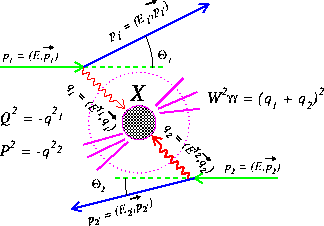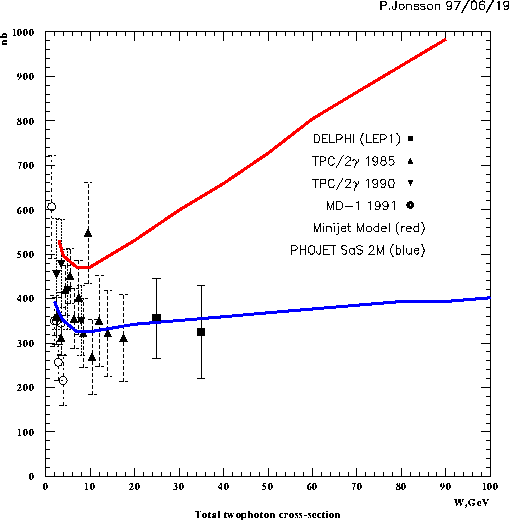|
When electrons and positrons interact in LEP they radiate photons at
small angles relative to the beam axis. This is the source of
two-photon collisions, producing a hadronic state X according to
 . While for a given beam energy the . While for a given beam energy the
 kinematics of an annihilation process is fixed, the continuos
spectra of the photons will allow simultaneous measurements at
different kinematics of an annihilation process is fixed, the continuos
spectra of the photons will allow simultaneous measurements at
different  invariant masses and for different momentum
transfers. invariant masses and for different momentum
transfers.
 The electron-photon vertices are pure QED processes and therefore
exactly calculable. The main interest lies instead in studying the
photon-hadron coupling, i.e. the coupling between photons and
quarks. For two-photon events with high momentum transfer this
coupling is best described by the Quark Parton Model (QPM), where the
photons have a point-like coupling to a quark which subsequently
fragments into hadrons. For smaller momentum transfers the Vector meson
Dominance Model (VDM) works better. Here the photons transform into
virtual vector mesons, which then interact through the strong force,
showing characteristics of soft hadron interactions. It has recently
been suggested that events with medium
The electron-photon vertices are pure QED processes and therefore
exactly calculable. The main interest lies instead in studying the
photon-hadron coupling, i.e. the coupling between photons and
quarks. For two-photon events with high momentum transfer this
coupling is best described by the Quark Parton Model (QPM), where the
photons have a point-like coupling to a quark which subsequently
fragments into hadrons. For smaller momentum transfers the Vector meson
Dominance Model (VDM) works better. Here the photons transform into
virtual vector mesons, which then interact through the strong force,
showing characteristics of soft hadron interactions. It has recently
been suggested that events with medium  multi-jet production can
be described by a QCD-based model of the hard scattering of the
photon's hadronic constituents, thus implicitly needing a gluon
component in the photon. Smooth transistions between these different
models are expected.
multi-jet production can
be described by a QCD-based model of the hard scattering of the
photon's hadronic constituents, thus implicitly needing a gluon
component in the photon. Smooth transistions between these different
models are expected.
It is possible to use forward electromagnetic calorimeters for tagging
one or both of the outgoing electrons for two-photon reactions. In
DELPHI the Small Angle Tagger (SAT) and Very Small Angle Tagger (VSAT)
are used for this purpose. These taggers are situated in the forward
and the very forward regions of DELPHI where the cross-section for
two-photon events is highest. Real events are compared with Monte
Carlo predictions generated using the above QPM, VDM and QCD
models. Initial results for the one-tagged events are promising, showing good
agreement between experiment and theory.
 By studying double tag events, where both the electrons are measured, it is
possible to fully determine the momentum carried by the photons. Thereby
getting a precise measurement of the invariant mass of the hadronic system.
Recent analysis of double tag events in the VSAT has measured the cross
section of two-photon events at invariant mass energies up to 35 GeV at LEP1.
By studying double tag events, where both the electrons are measured, it is
possible to fully determine the momentum carried by the photons. Thereby
getting a precise measurement of the invariant mass of the hadronic system.
Recent analysis of double tag events in the VSAT has measured the cross
section of two-photon events at invariant mass energies up to 35 GeV at LEP1.
The SAT was replaced in 1994 by a new
calorimeter, the Small angle TIle Calorimeter (STIC).
The use of STIC and VSAT as taggers for two-photon events will be important
at LEP200 where this type of collisions will dominate. In 1998 the radius of
the beampipe will be decreased by 1 cm, giving the VSAT access to a higher
accepted cross section at smaller polar angles.
People Involved
- Göran Jarlskog
- Sverker Almehed
- Per Jonsson
- Nikolai Zimin
Ivan Kronkvist, Per Jonsson
October 12 1997
|
 . While for a given beam energy the
. While for a given beam energy the
 kinematics of an annihilation process is fixed, the continuos
spectra of the photons will allow simultaneous measurements at
different
kinematics of an annihilation process is fixed, the continuos
spectra of the photons will allow simultaneous measurements at
different  invariant masses and for different momentum
transfers.
invariant masses and for different momentum
transfers.
 The electron-photon vertices are pure QED processes and therefore
exactly calculable. The main interest lies instead in studying the
photon-hadron coupling, i.e. the coupling between photons and
quarks. For two-photon events with high momentum transfer this
coupling is best described by the Quark Parton Model (QPM), where the
photons have a point-like coupling to a quark which subsequently
fragments into hadrons. For smaller momentum transfers the Vector meson
Dominance Model (VDM) works better. Here the photons transform into
virtual vector mesons, which then interact through the strong force,
showing characteristics of soft hadron interactions. It has recently
been suggested that events with medium
The electron-photon vertices are pure QED processes and therefore
exactly calculable. The main interest lies instead in studying the
photon-hadron coupling, i.e. the coupling between photons and
quarks. For two-photon events with high momentum transfer this
coupling is best described by the Quark Parton Model (QPM), where the
photons have a point-like coupling to a quark which subsequently
fragments into hadrons. For smaller momentum transfers the Vector meson
Dominance Model (VDM) works better. Here the photons transform into
virtual vector mesons, which then interact through the strong force,
showing characteristics of soft hadron interactions. It has recently
been suggested that events with medium  multi-jet production can
be described by a QCD-based model of the hard scattering of the
photon's hadronic constituents, thus implicitly needing a gluon
component in the photon. Smooth transistions between these different
models are expected.
multi-jet production can
be described by a QCD-based model of the hard scattering of the
photon's hadronic constituents, thus implicitly needing a gluon
component in the photon. Smooth transistions between these different
models are expected.
